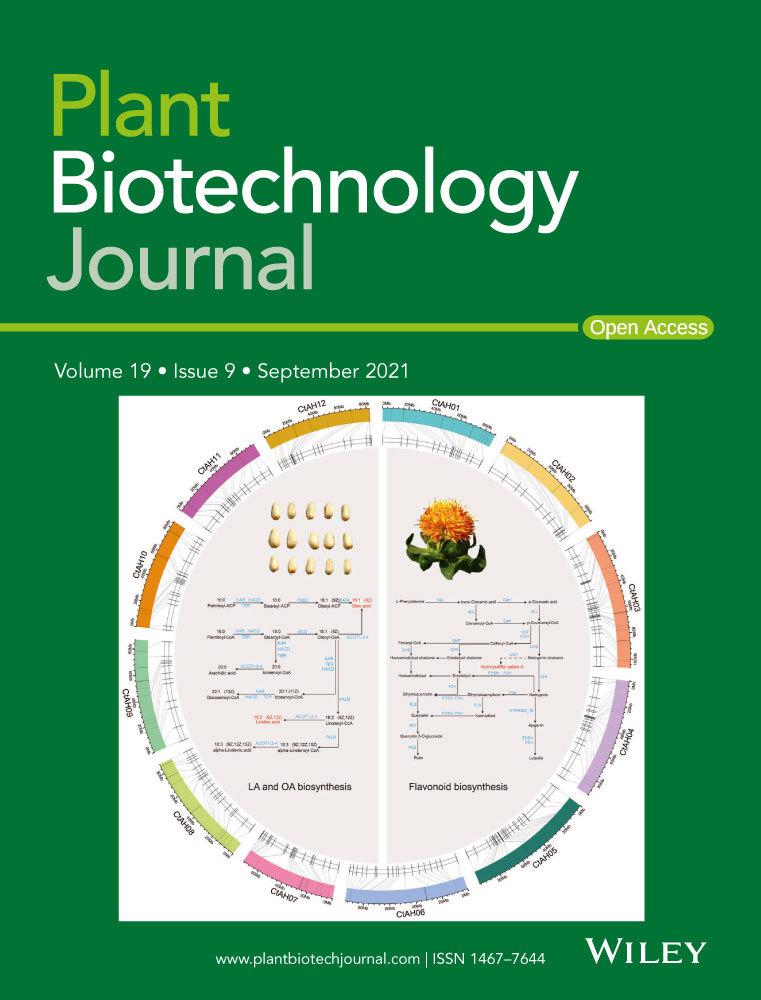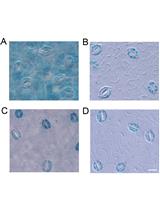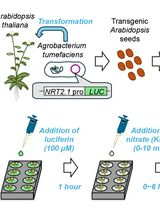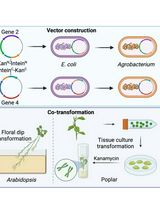- EN - English
- CN - 中文
Inoculation of Maize with Sugarcane Mosaic Virus Constructs and Application for RNA Interference in Fall Armyworms
用甘蔗花叶病毒构建体接种玉米并应用于秋季棉铃虫的RNA干扰
发布: 2023年07月20日第13卷第14期 DOI: 10.21769/BioProtoc.4760 浏览次数: 1985
评审: Zhibing LaiDemosthenis ChronisMalgorzata LichockaJuliane K Ishida
Abstract
Virus-mediated transient gene overexpression and gene expression silencing can be used to screen gene functions in plants. Sugarcane mosaic virus (SCMV) is a positive strand RNA virus in the Potyviridae family that has been modified to be used as vector to infect monocots, including maize (Zea mays), for transient gene overexpression and gene expression silencing. Relative to stable transformation, SCMV-mediated transient expression in maize has the advantages of being faster and less expensive. Here, we describe a protocol for cloning constructs into the plasmid vector pSCMV-CS3. After maize seedlings are transformed with pSCMV-CS3 constructs by particle bombardment, the virus replicates and spreads systemically in the plants. Subsequent infections of maize seedlings can be accomplished by rub inoculation with sap from SCMV-infested plants. As an example of a practical application of the method, we also describe virus-induced gene silencing (VIGS) of fall armyworm (Spodoptera frugiperda) gene expression. Transgenic viruses are created by cloning a segment of the fall armyworm target gene into pSCMV-CS3 prior to maize transformation. Caterpillars are fed on the virus-infected maize plants, which make dsRNA to silence the expression of the fall armyworm target gene after ingestion. This use of SCMV for plant-mediated VIGS in insects allows rapid screening of gene functions when caterpillars are feeding on their host plants.
Graphical overview
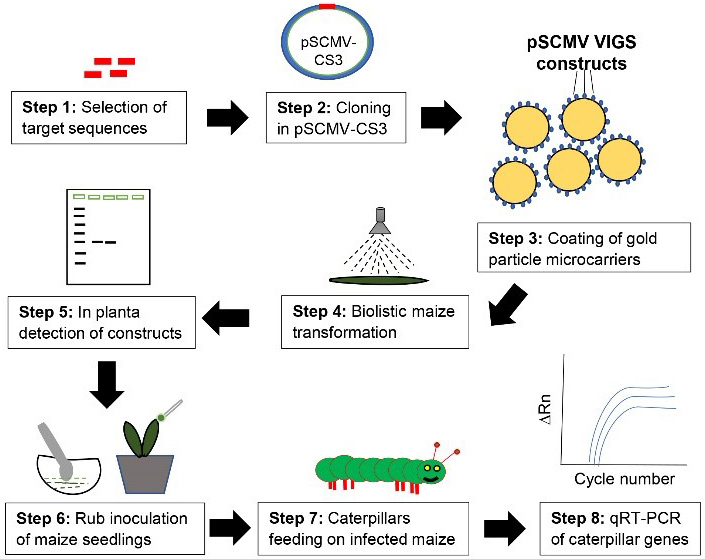
Background
Viruses can be engineered as vectors for overexpression of heterologous coding or non-coding RNA sequences in plants. Additionally, viruses carrying a fragment of a target gene can cause virus-induced gene silencing (VIGS) by activating the internal RNA interference (RNAi) machinery of their host plants (Pasin et al., 2019). The rapid replication of plant viruses makes VIGS an efficient approach for in vivo investigation of gene function in plants.
Several virus vectors have been used for VIGS in monocot plant species, including Chinese wheat mosaic virus (Yang et al., 2018), tobacco rattle virus (TRV) (Zhong et al., 2014), barley stripe mosaic virus (Buhrow et al., 2016), brome mosaic virus (Wang et al., 2021), bamboo mosaic virus, cymbidium mosaic virus (Hsieh et al., 2013), rice tungro bacilliform virus (Purkayastha et al., 2010), cucumber mosaic virus (Tzean et al., 2019), foxtail mosaic virus (Liu et al., 2016), maize rayado fino virus (Mlotshwa et al., 2020), and sugarcane mosaic virus (SCMV) (Mei et al., 2019; Chung et al., 2022). Several of these viruses, including SCMV, have been used for VIGS in maize (Mei et al., 2016; Wang et al., 2016; J. Zhang et al., 2017; Ding et al., 2018; Jarugula et al., 2018; Mlotshwa et al., 2020; Chung et al., 2022)
SCMV is a positive strand RNA virus of the Potyviridae family that infects many monocots including sugarcane, maize, wheat, and sorghum (Xiao et al., 1993). Previously, SCMV has been used as a vector for transient overexpression of non-maize genes (Mei et al., 2019), overexpression of maize endogenous genes (Chung et al., 2021), VIGS of maize endogenous genes (Chung et al., 2022), and plant-mediated VIGS of gene expression in corn leaf aphids (Rhopalosiphum maidis) feeding on maize (Chung and Jander, 2022). The plasmid vector pSCMV-CS3 (Mei et al., 2019; Chung et al., 2022) allows for both efficient gene overexpression and gene expression silencing by RNA interference. The entire SCMV virus is encoded between a cauliflower mosaic virus 35S promoter and a nopaline synthase terminator in the Escherichia coli plasmid pSCMV-CS3. A multiple cloning site, which allows cutting by the enzymes PspOMI, ApaI, PmeI, PstII, and SbfI, is inserted between the P1 and HC-Pro protein-coding regions of the virus. Since the virus is translated as a single polyprotein, prior to being cleaved by virus-encoded proteases, it is essential that there is no in-frame stop codon in the sequence that is cloned into pSCMV-CS3. A NIa protease cleavage site immediately downstream of the multiple cloning site catalyzes the release of the cloned protein from the endogenous viral proteins. Biolistic transformation of pSCMV-CS3 into plant cells causes the virus to be transcribed from the 35S promotor, thereby initiating a systemic viral infection.
The fall armyworm (Spodoptera frugiperda), a lepidopteran insect in the Noctuidae family, is one of the most important pests of maize, causing considerable damage to this important crop worldwide. It is a native North American species that has expanded its range to Africa and Asia in recent years (Rwomushana, 2019). The larval stage preferably consumes the tender shoots and leaves of maize plants (He et al., 2020). Currently available strategies such as use of chemical insecticides (Sisay et al., 2019) and transgenic maize producing Bt (Bacillus thuringiensis) toxin (Niu et al., 2016) are becoming less effective due to resistance that is developing in the pests (Banerjee et al., 2017; Zhang et al., 2020) However, RNAi has emerged as a promising approach for agricultural pest control (Zotti et al., 2018). RNAi of insect genes can be achieved by feeding them on host plants with either stable or transient expression of double-stranded RNA (dsRNA) targeting specific inset genes.
Plant-mediated RNAi has been used to silence expression of lepidopteran genes, including silencing of tobacco hornworm (Manduca sexta) genes by stable (Poreddy et al., 2017) or transient expression of dsRNA in tobacco using TRV (Kumar et al., 2012), and stable expression of dsRNA of cotton bollworm (Helicoverpa armigera) genes in Arabidopsis thaliana (Chen et al., 2019), Nicotiana benthamiana (Bally et al., 2020), cotton (Gossypium hirsutum) (Tian et al., 2015; Mao et al., 2007), and tomato (Lycopersicum esculentum) (Mamta et al., 2016). Most of these studies used expression of RNA in stable transgenic plants, an approach that is a laborious, relatively expensive, and low-throughput strategy for studying gene function in plant pests. By contrast, using viruses as vectors for transient expression of dsRNA is a robust method for generating a rapid and systemic RNAi signal in plants.
Here, we describe a general protocol for infecting maize with pSCMV-CS3 gene constructs, as well as the specific use of SCMV-mediated VIGS for silencing gene expression in fall armyworm caterpillars that are feeding on infected maize plants. When the maize RNAi pathway is activated by SCMV infection, viral dsRNA is cleaved into short interfering RNA (siRNA) of 21–24 nucleotides in length (Ding and Voinnet, 2007). Upon feeding on SCMV-infected maize, fall armyworm caterpillars ingest dsRNA and/or siRNA, which silences expression of the target gene.
Materials and reagents
Plants, insects, vectors, and cell lines
Zea mays inbred line P39 seeds (Maize COOP, http://maizecoop.cropsci.uiuc.edu)
Sweet corn variety Golden Bantam (Burpee Seeds, Warminster Township, PA, or www.amazon.com)
Fall armyworm (Spodoptera frugiperda) eggs (Benzon Research, Carlisle, PA, USA, www.benzonresearch.com)
pSCMV-CS3 (plasmid with a SCMV cloning site #3). This plasmid can be obtained with a material transfer agreement from Iowa State University; contact Dr. Steve Whitham (
swhitham@iastate.edu )Escherichia coli DH5α competent cells (Thermo Fisher, catalog number: 18265017)
pSCMV-GFP and pSCMV-GOI (Gene of Interest)
Oligonucleotides (Integrated DNA Technologies, USA)
Flanking multiple cloning site of pSCMV-CS3
SP7788: 5′-GCACAAATGGTTTCCAACG-3′
SP7789: 5′-ATGTTGCATGTCTTGCATG-3′
Reference maize gene primers for reverse-transcriptase PCR (RT-PCR)
Actin-F, 5′-GGTTTCGCTGGTGATGATGC-3′
Actin-R, 5′-CAATGCCATGCTCAATCGGG-3′
EF-1α-F, 5′-TGGGCCTACTGGTCTTACTACTGA-3′
EF-1α-R, 5′-ACATACCCACGCTTCAGATCCT-3′
Reference fall armyworm gene primers for quantitative reverse transcriptase-PCR (qPCR)
qrSF-RPL13-F, 5′-GCCTTAACCCTGCTTTTGCTAG-3′
qrSF-RPL13-R, 5′-GCTTCGCCCTTCAATACCTTC-3′
qrSF-EF1α-F, 5′-TGGGCGTCAACAAAATGGA-3′
qrSF-EF1α-R, 5′-TCTCCGTGCCAGCCAGAAAT-3′
Primers for VIGS target gene cloning and quantitative PCR (will vary based on the gene of interest)
Materials
Wizard® SV Gel and PCR clean-up system (Promega, catalog number: A9282)
Wizard® Plus SV Minipreps DNA purification system (Promega, catalog number: A1460)
Wizard® SV total RNA isolation system (Promega, catalog number: Z3100)
High-Capacity cDNA Reverse Transcription kits (Applied Biosystems, catalog number: 4374966)
GoTaq® Green Master Mix (Promega, catalog number: M7123)
PowerUpTM SYBRTM Green Master Mix (Applied Biosystems, catalog number: A25742)
Restriction enzymes: PspOMI, SbfI (NEB Biolabs, catalog number: R0653S and R3642)
T4 DNA ligase (Promega, catalog number: M1804)
100 bp DNA ladder (Promega, catalog number: G210A)
Nuclease-free water
Absolute ethanol (Sigma-Aldrich, catalog number: E7023)
Liquid nitrogen
Carborundum powder (Fisher, catalog number: C192-500)
Mortar and pestle
Pellet pestle (Fisher Scientific, catalog number: 12-141-363)
Biolistic Optimization kit [1.0 μm Gold Microcarriers, Macrocarrier disks, stopping screens, and 7,600 kPa (1,100 psi) rupture disks (Bio-Rad Laboratories, catalog number: 165-2279)]
0.1 M spermidine (Sigma-Aldrich, catalog number: 05292-1ML-F)
Pipettes and pipette tips (various)
Agarose low-EEO/multi-purpose/molecular biology grade (Fisher BioReagentsTM, catalog number BP160-100)
Microperforated plastic vented bread bags (30 cm × 60 cm) (www.amazon.com)
Plant trays without holes (28 cm wide × 54 cm long × 6 cm deep), plastic pots (9 cm square, 8 cm deep) (www.amazon.com)
qPCR plates (MicroAmpTM optical 384-well reaction plate with barcode (Applied Biosystems, catalog number: 43-098-49)
Cornell maize soil mix: [0.16 m3 Metro-Mix 360 (Scotts, Marysville, OH, USA), 0.45 kg finely ground lime, 0.45 kg Peters Unimix (Griffin Greenhouse Supplies, Auburn, NY, USA), 68 kg Turface MVP (Banfield-Baker Corp., Horseheads, NY, USA), 23 kg coarse quartz sand, and 0.018 m3 pasteurized field soil]
Fall armyworm artificial diet (Southland Products Inc, Lake Village, AR, USA, www.southlandproducts.net)
50 mg/mL kanamycin stock solution (Sigma-Aldrich, catalog number: K0254-20ML)
CaCl2·6H2O (Sigma-Aldrich, catalog number: 21108-500G)
Tryptone (Sigma-Aldrich, catalog number: T7293-1KG)
NaCl (Sigma-Aldrich, catalog number: S9888-1G)
Yeast extract (Sigma-Aldrich, catalog number: 70161-500G)
Agar (Sigma-Aldrich, catalog number: A1296-500G)
15 cm Petri dishes (Fisher Scientific, catalog number FB0875714)
0.22 μm syringe filters (Corning®, catalog number: CLS431219-50EA)
Monobasic potassium phosphate (KH2PO4) (Sigma-Aldrich, catalog number: P0662-500G)
Dibasic potassium phosphate, (K2HPO4) (Sigma-Aldrich, catalog number: P3786-500G)
Tris base (Sigma-Aldrich, catalog number: T1503-500G)
Acetic acid (Sigma-Aldrich, catalog number: A6283-1L)
EDTA (Sigma-Aldrich, catalog number: E4884-500G)
Glycerol (Sigma-Aldrich, catalog number: G7893-IL)
Buffers and solutions
2.5 M CaCl2 (see Recipes)
LB medium (see Recipes)
Inoculation buffer (see Recipes)
1× TAE buffer (see Recipes)
50% (v/v) glycerol (see Recipes)
70% ethanol (see Recipes)
LB agar plates (see Recipes)
Recipes
2.5 M CaCl2
Dissolve 11.0 g of CaCl2·6H2O in deionized water and make the volume up to 20 mL, filter sterilize with a 0.22 μm filter, and store at 4 °C.
LB medium
1% (w/v) tryptone
1% (w/v) NaCl
0.5% (w/v) yeast extract
pH 7.5
Inoculation buffer (50 mM potassium phosphate)
43.4 mL of 1 M KH2PO4
6.6 mL of 1 M K2HPO4
Bring volume to 1 L with deionized water
pH 6.0
1× Tris-Acetate-EDTA (TAE) buffer
242 g of Tris base
57.1 mL of glacial acetic acid
18.6 g of EDTA
Bring final volume to 1 L with deionized water
This is a 50 × TAE stock solution, dilute 1:50 to make 1× TAE buffer
50% (v/v) glycerol
50 mL of 100% glycerol in 50 mL of deionized water
70% ethanol
70 mL of absolute ethanol in 30 mL of deionized water
LB agar plates
LB medium (see Recipe 2)
1.5% w/v agar
Boil to dissolve the agar
Pour approximately 25 mL of heated LB agar into each Petri dish
Equipment
NanoDrop ND-1000 spectrophotometer (Thermo Fisher, USA)
PDS-1000/He biolistic particle delivery system with metal mesh (Bio-Rad laboratories, USA)
1600 MiniG® automated tissue homogenizer and cell lyser (SPEX® Sample Prep, USA)
QuantStudio 6 Flex real-time PCR system (Applied Biosystems, USA)
Ultrasonic water bath with 40 kHz frequency and 284 W heater power (FS140H, Fisher Scientific, USA)
Plate centrifuge (Benchmark Scientific, USA)
Vortex (American Scientific Products, USA)
Benchtop centrifuge (Thermo Scientific, USA)
Incubator with temperature set at 37 °C
Incubator with temperature set at 28 °C
Shaker with temperature set at 37 °C
Plant growth chambers
Procedure
文章信息
版权信息
© 2023 The Author(s); This is an open access article under the CC BY-NC license (https://creativecommons.org/licenses/by-nc/4.0/).
如何引用
Gull, I. and Jander, G. (2023). Inoculation of Maize with Sugarcane Mosaic Virus Constructs and Application for RNA Interference in Fall Armyworms. Bio-protocol 13(14): e4760. DOI: 10.21769/BioProtoc.4760.
分类
植物科学 > 植物分子生物学 > DNA > 基因表达
分子生物学 > DNA > DNA 克隆
您对这篇实验方法有问题吗?
在此处发布您的问题,我们将邀请本文作者来回答。同时,我们会将您的问题发布到Bio-protocol Exchange,以便寻求社区成员的帮助。
提问指南
+ 问题描述
写下详细的问题描述,包括所有有助于他人回答您问题的信息(例如实验过程、条件和相关图像等)。
Share
Bluesky
X
Copy link


